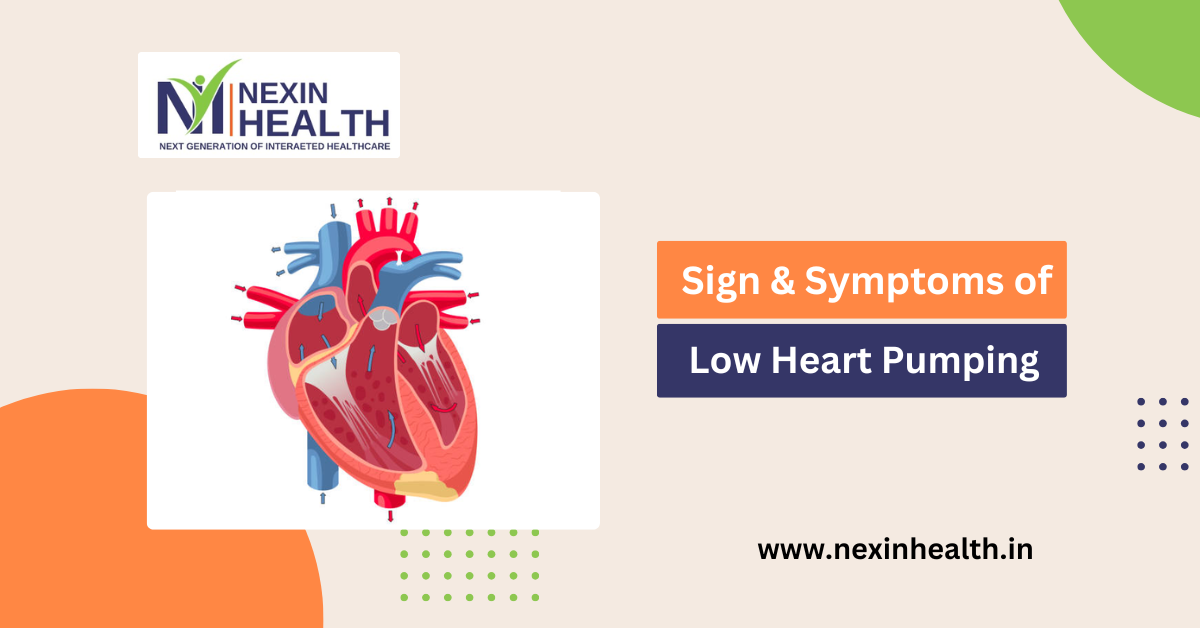Symptoms of Low Heart Pumping


Symptoms of Low Heart Pumping: The heart is a marvel of nature—a muscular organ tirelessly working to pump blood throughout the body. But what happens when the heart doesn’t pump blood as efficiently as it should? This condition, often referred to as low heart pumping or reduced ejection fraction, can lead to serious health concerns if not addressed promptly.
At NexIn Health Clinic, we specialize in Enhanced External Counterpulsation (EECP) Therapy, a revolutionary non-invasive treatment to improve heart function.
Let’s explore the symptoms of low heart pumping, its causes, and how EECP therapy can offer a new lease on life.
Low heart pumping occurs when the heart’s ability to pump blood is compromised. In medical terms, this is known as heart failure with reduced ejection fraction (HFrEF). The ejection fraction is the percentage of blood the heart pumps out of the left ventricle with each beat. A normal ejection fraction is between 50–70%, but when it falls below 40%, it is classified as low.
This condition affects the delivery of oxygen and nutrients to vital organs, leading to a range of symptoms that can significantly impact daily life.
Recognizing the symptoms of low heart pumping is crucial for timely intervention. These symptoms often develop gradually but can worsen if left untreated. Here are the key signs to watch out for:
A common and early symptom, shortness of breath may occur during physical activity, while lying flat, or even at rest in severe cases. This happens because fluid backs up in the lungs due to inefficient heart pumping.
Low cardiac output leads to reduced oxygen delivery to muscles, causing persistent fatigue and a lack of energy for routine activities.
Fluid retention, often seen in the ankles, feet, legs, or abdomen, is another hallmark symptom. This occurs as the kidneys retain sodium and water due to reduced blood flow.
Palpitations or an irregular pulse may be noticeable as the heart tries to compensate for its inefficiency.
Persistent coughing, especially at night, may occur due to fluid accumulation in the lungs.
Simple tasks like climbing stairs or walking short distances may feel overwhelmingly difficult.
Reduced blood flow to the brain can lead to cognitive difficulties, such as confusion or forgetfulness.
In some cases, chest pain may indicate underlying heart conditions contributing to low heart pumping.
If you experience any of these symptoms, seeking medical attention is critical to prevent complications.
Understanding what causes low heart pumping can help guide effective treatment. Here are some leading contributors:
Narrowing or blockages in the coronary arteries reduce blood flow to the heart, weakening its pumping ability over time.
A previous heart attack can damage heart muscle, leaving it unable to contract effectively.
Diseases of the heart muscle, such as dilated or hypertrophic cardiomyopathy, impair the heart’s functionality.
Chronic high blood pressure forces the heart to work harder, which may eventually weaken it.
Damaged or malfunctioning heart valves can disrupt blood flow, straining the heart.
Uncontrolled diabetes can lead to heart damage and contribute to reduced heart function.
Poor diet, smoking, obesity, and lack of exercise significantly increase the risk of heart failure.
Early diagnosis and lifestyle changes can slow the progression of low heart pumping.
Enhanced External Counterpulsation (EECP) therapy is a non-invasive, FDA-approved treatment for improving heart function. It works by enhancing blood flow and encouraging the formation of new blood vessels (collateral circulation).
At NexIn Health Clinic, we’ve seen remarkable improvements in patients with low heart pumping through our EECP therapy programs.
By enhancing circulation, EECP therapy delivers more oxygen to the heart and other organs.
Patients often report better stamina and less fatigue after completing the therapy.
Unlike surgeries or invasive procedures, EECP therapy involves no incisions, anesthesia, or recovery time.
EECP helps alleviate symptoms like shortness of breath, chest pain, and swelling.
It stimulates natural bypasses (collateral vessels) around blocked arteries, improving overall heart function.
EECP therapy is especially beneficial for individuals with:
At NexIn Health Clinic, we carefully evaluate each patient’s medical history to tailor the treatment plan for maximum benefit.
At NexIn Health Clinic, we combine state-of-the-art technology with personalized care to address your heart health needs. Here’s why patients trust us:
While EECP therapy can significantly improve heart function, adopting a heart-healthy lifestyle is crucial for sustaining benefits. Here are some tips:
Living with low heart pumping can be challenging, but it doesn’t have to define your life. At NexIn Health Clinic, our advanced EECP therapy offers a safe, effective, and non-invasive solution to improve heart function and alleviate symptoms. By combining cutting-edge treatment with lifestyle changes, you can take charge of your heart health and enjoy a better quality of life.
If you or a loved one is experiencing symptoms of low heart pumping, don’t wait. Contact NexIn Health Clinic today to schedule a consultation and learn more about how EECP therapy can transform your heart health.
Also Read: